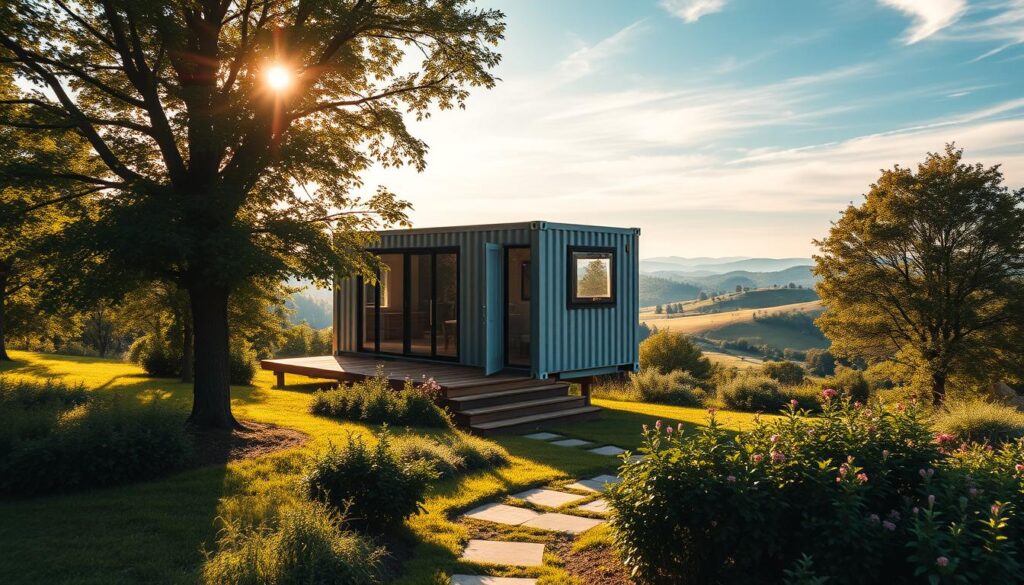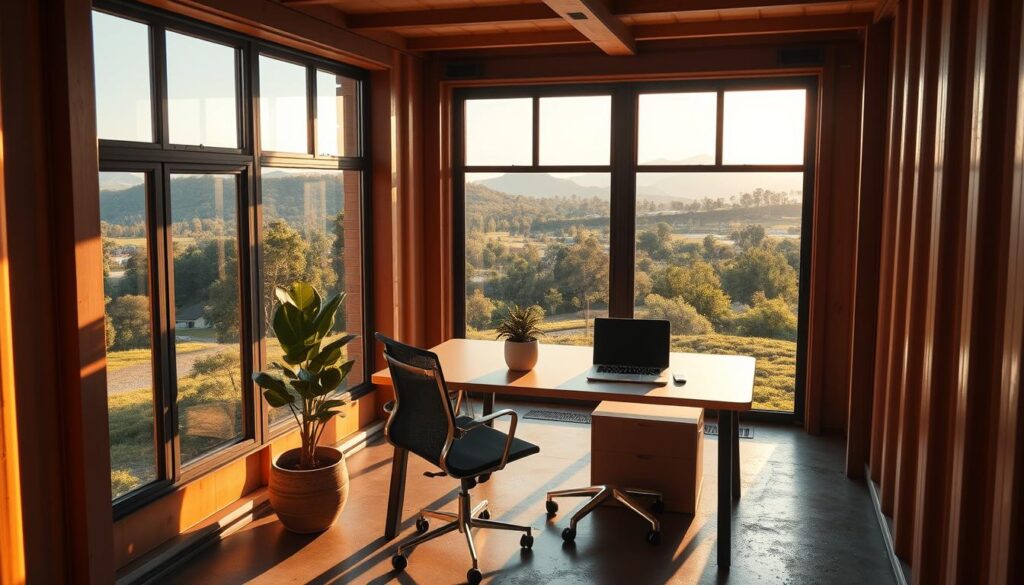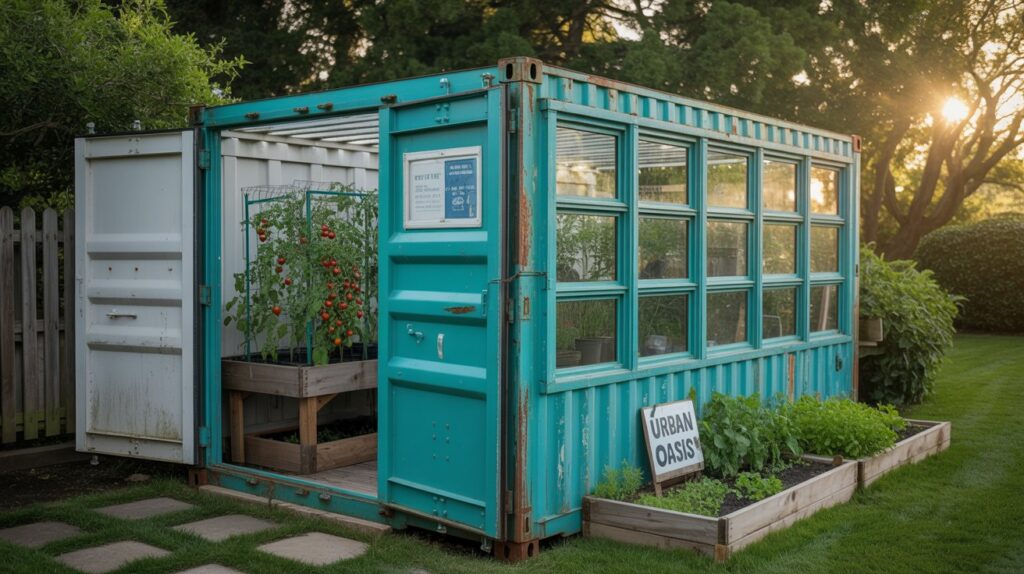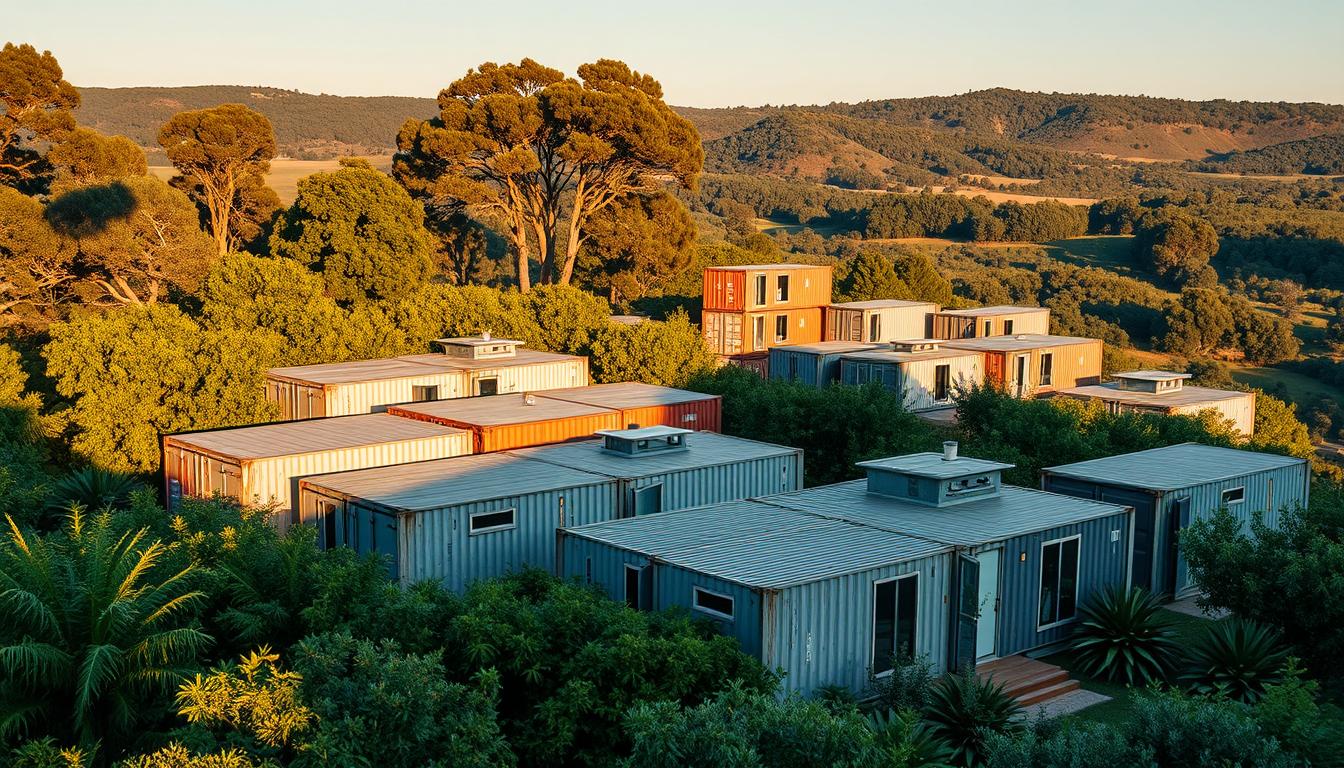Shipping containers have become a popular solution for various needs, from storage solutions to unique living spaces. The demand for these containers has skyrocketed in recent years due to their versatility, sustainability, and affordability.
The idea of repurposing shipping containers is not only eco-friendly but also offers a wide range of creative possibilities for homeowners and businesses alike. Whether you’re looking to create additional storage solutions or even a shipping container home, the options are vast and varied.
Key Takeaways
- Discover the versatility of shipping containers for various property needs.
- Explore cost-effective solutions for storage and living spaces.
- Learn about the eco-friendly benefits of repurposing shipping containers.
- Find out how shipping containers can be used for business purposes.
- Understand the potential of shipping container homes as a sustainable living option.
The Versatility of Shipping Containers for Property Owners
With their robust construction and adaptability, shipping containers offer a wide range of possibilities for property enhancement. Property owners are discovering the numerous benefits of utilizing shipping containers for various purposes, from storage and living spaces to entertainment and agricultural applications.
Why Shipping Containers Are Gaining Popularity
Shipping containers are becoming increasingly popular among property owners due to their sustainability and eco-friendly aspects. Repurposing shipping containers reduces waste and minimizes the environmental impact associated with traditional construction methods.
Sustainability and Eco-Friendly Aspects
The eco-friendly nature of shipping containers is a significant factor in their growing popularity. By reusing these containers, property owners can reduce their carbon footprint and contribute to a more sustainable future. Eco-conscious individuals are particularly drawn to this aspect, as it aligns with their values of reducing, reusing, and recycling.
Availability and Accessibility
Shipping containers are widely available and can be easily transported to various locations, making them a convenient option for property owners. Their accessibility allows for a broad range of applications, from DIY projects to large-scale commercial ventures.
Key Benefits: Durability, Cost-Effectiveness, and Flexibility
The durability, cost-effectiveness, and flexibility of shipping containers make them an attractive solution for property owners. These containers can withstand harsh weather conditions and can be easily modified to suit various needs.
Weather Resistance and Longevity
Shipping containers are designed to be weather-resistant, ensuring that they remain functional over time. Their longevity is a significant advantage, as it reduces the need for frequent replacements or repairs. This aspect is particularly beneficial for property owners who require durable storage solutions or living spaces.
Modular Design Advantages
The modular design of shipping containers allows for easy customization and expansion. Property owners can combine multiple containers to create larger spaces or modify individual containers to fit specific needs. This flexibility is particularly useful for outdoor living spaces and shipping container homes, where creativity and adaptability are key.
1. Storage Solutions: Organize Your Property with Container Storage
Shipping containers provide a secure and efficient way to store tools, equipment, and other valuable items on your property. With the ability to be customized and modified, they offer a versatile storage solution that can meet various needs.
Secure Storage for Tools and Equipment
One of the primary benefits of using shipping containers for storage is the security they offer. Containers can be equipped with advanced security features such as:
- Heavy-duty locks
- Surveillance cameras
- Alarm systems
Security Features and Modifications
To enhance security, containers can be modified with reinforced doors and frames, making them highly resistant to unauthorized access. “The right security measures can significantly reduce the risk of theft and damage,” as noted by security experts.
Shelving and Organization Systems
Effective storage is not just about security; it’s also about organization. Containers can be fitted with shelving units and organization systems to maximize space and ensure that tools and equipment are easily accessible.
Climate Control Options for Sensitive Items
For items that are sensitive to temperature and humidity, shipping containers can be equipped with climate control options. This includes:
- Insulation to regulate temperature
- Dehumidifiers to control humidity levels
Insulation Methods for Temperature Regulation
Insulation is key to maintaining a stable temperature inside the container. Methods include adding foam insulation or reflective insulation to the container walls and ceiling.
Humidity Control Solutions
To prevent moisture damage, humidity control solutions such as dehumidifiers can be installed. This is particularly important for storing sensitive equipment or materials.
By utilizing shipping containers for storage, property owners can enjoy a secure, organized, and climate-controlled space for their tools and equipment. This not only enhances the functionality of the property but also adds value by providing a practical solution for storage needs.
2. Tiny Home or Guest House: Container Living Spaces
Shipping containers can be repurposed into cozy tiny homes or guest houses, offering a unique living solution. This innovative approach to housing is not only eco-friendly but also highly customizable.
Converting Containers into Comfortable Living Quarters
The process of converting a shipping container into a living space involves careful planning and design. It’s essential to optimize the floor plan to make the most of the available space.
Floor Plans and Space Optimization
Effective floor plans are crucial for container homes. Consider multi-functional furniture and open layouts to maximize space. Some popular layouts include:
- Studio style with combined living areas
- Loft designs for additional sleeping space
- Galley kitchen layouts for efficiency
Windows and Natural Light Solutions
Incorporating windows and skylights can significantly enhance the ambiance of a container home. Options include:
- Cutting out sections of the container for large windows
- Installing skylights or solar tubes for natural light
- Using glass doors to connect indoor and outdoor spaces

Insulation and Interior Finishing Considerations
Proper insulation is vital for maintaining a comfortable temperature inside the container home. Consider spray foam insulation or reflective insulation for optimal results.
Wall and Ceiling Treatments
Finishing the interior walls and ceilings can greatly impact the overall feel of the space. Popular choices include:
- Drywall for a smooth finish
- Wood paneling for a rustic look
Flooring Options for Container Homes
The choice of flooring can greatly affect the comfort and aesthetic of the container home. Options range from hardwood flooring to porcelain tile, each offering unique benefits.
3. Home Office or Studio Space: Work from Your Property
Shipping containers offer a versatile solution for creating a dedicated workspace on your property. With the rise of remote work, having a productive and comfortable home office is more important than ever.

Creating the Perfect Container Workspace
To create an effective home office within a shipping container, it’s crucial to consider the layout and furniture. Proper planning can maximize the available space.
Desk and Furniture Placement
Strategic placement of your desk and furniture is essential. Consider positioning your desk near a window for natural light, and use multi-functional furniture to save space.
Storage Solutions for Office Supplies
Adequate storage is vital for maintaining an organized workspace. Incorporate shelving units and cabinets to keep your office supplies within easy reach.
Connectivity and Technology Integration
For a home office to be effective, it needs to be well-connected. This includes reliable internet and sufficient power supply for your equipment.
Internet and Communication Setup
Ensure that your container office has a robust internet connection. Consider installing a wired connection for reliability and security.
Power Requirements for Office Equipment
Assess your power needs based on the equipment you’ll be using. Installing sufficient outlets and considering backup power sources, like generators or UPS systems, can be beneficial.
| Feature | Benefit | Consideration |
|---|---|---|
| Natural Light | Improves productivity and mood | Window placement |
| Multi-functional Furniture | Saves space, enhances functionality | Choose furniture that serves multiple purposes |
| Reliable Internet | Ensures connectivity and communication | Invest in a secure and fast internet connection |
By carefully planning your shipping container home office, you can create a productive and comfortable workspace that meets your needs. Whether you’re working remotely or running a business, a well-designed container office can be a valuable asset.
4. Backyard Workshop: DIY and Hobby Spaces
With a shipping container, you can establish a well-organized backyard workshop tailored to your needs. This conversion not only enhances your DIY capabilities but also provides a dedicated space for various hobby activities.
Setting Up a Functional Workshop Layout
To maximize the utility of your shipping container workshop, it’s crucial to plan the layout effectively. Consider the workflow and ensure there’s enough space for your tools and equipment.
Workbench Placement and Design
A well-designed workbench is central to any workshop. Position it in a way that optimizes your workflow and provides ample storage for your tools.
Power and Ventilation Solutions
Adequate power supply and ventilation are critical for a functional workshop. Ensure you have the necessary electrical infrastructure and consider installing ventilation systems to maintain air quality.
Electrical Requirements for Power Tools
Assess the power requirements of your tools and equipment to determine the appropriate electrical setup for your workshop.
Air Circulation and Dust Management
Proper ventilation is essential for removing dust and fumes from your workshop. Consider installing fans or a dust collection system to maintain a clean and safe working environment.

By converting a shipping container into a backyard workshop, you can create a versatile space that meets your DIY and hobby needs. With careful planning and the right infrastructure, your workshop will become a valuable addition to your property.
5. Container Gardening and Greenhouse Applications
Repurposing shipping containers into gardening spaces is an innovative way to maximize property use and create productive growing areas. This approach not only reuses existing structures but also provides a unique solution for gardening enthusiasts. By transforming shipping containers into gardens or greenhouses, property owners can enjoy a variety of benefits, including increased growing space and improved crop yields.
Transforming Containers into Productive Growing Spaces
To convert shipping containers into effective gardening spaces, several factors must be considered. One of the primary concerns is ensuring adequate light access for plants. This can be achieved by modifying the container’s structure.
Roof Removal and Light Access
Removing the roof or a portion of it allows for natural light to penetrate the container, creating a more conducive environment for plant growth. This modification also enables the installation of glazing or other transparent materials to protect plants from the elements.
Drainage and Water Management
Proper drainage is crucial to prevent waterlogged soil and root rot. Implementing a drainage system within the container ensures that excess water is managed effectively, maintaining a healthy environment for plants.

Vertical Gardening and Space Maximization
To maximize space within the container, vertical gardening techniques can be employed. This involves using the container’s walls to grow plants, increasing the overall growing area.
Wall-Mounted Planting Systems
Wall-mounted planting systems allow for the attachment of planters or pockets directly to the container’s walls, making efficient use of space and adding a decorative element to the garden.
Tiered Growing Platforms
Tiered growing platforms provide another effective method for maximizing space. By stacking planters or growing areas, property owners can cultivate a greater variety of plants within a limited footprint.
By incorporating these techniques, shipping containers can be transformed into thriving gardens and greenhouses, enhancing outdoor living spaces and providing a unique gardening experience.
6. Rental Income Opportunities with Top8 Uses for Shipping Containers on Your Property
Rental income opportunities abound when you convert shipping containers into unique spaces. Whether you’re looking to create a vacation rental, a commercial space, or a mobile office, shipping containers offer a versatile and profitable solution.
Container Vacation Rentals and Unique Stays
Converting shipping containers into vacation rentals can be a lucrative venture, especially in areas popular with tourists. Platforms like Airbnb have made it easier to market unique accommodations, attracting travelers looking for something different.
Marketing Your Container Accommodation
To maximize occupancy, focus on highlighting the unique features of your container accommodation. Use high-quality photos and emphasize the exclusive experience your guests will have.
Amenities That Attract Guests
Providing amenities such as Wi-Fi, comfortable furnishings, and locally sourced decor can significantly enhance the appeal of your container rental, attracting more guests and potentially higher ratings.
Commercial Rental Possibilities
Beyond vacation rentals, shipping containers can also be converted into commercial spaces, such as retail stores, cafes, or mobile offices. This can be particularly appealing for businesses looking for a unique or temporary location.
Pop-Up Retail Spaces
Containers make ideal pop-up retail spaces, allowing businesses to test new markets or create seasonal stores with minimal upfront costs.
Mobile Business Opportunities
For businesses that need to move locations frequently, a shipping container conversion can serve as a mobile office or service hub, offering flexibility and cost savings.
7. Entertainment Spaces: Container Bars, Game Rooms, and More
With a little creativity, shipping containers can become the ultimate entertainment spaces, from bars to game rooms. By repurposing these containers, property owners can create unique venues that foster social gatherings and memorable experiences.
Creating Social Gathering Spaces
To create an inviting entertainment space, consider the layout and functionality. A well-designed container bar or game room can become the centerpiece of your social gatherings.
Bar and Serving Area Designs
Designing an efficient bar area involves optimizing the layout for serving and socializing. Consider incorporating a counter, stools, and ample storage for beverages and glassware.
Seating and Comfort Considerations
Comfortable seating is crucial for creating a welcoming atmosphere. Choose durable, stylish furniture that complements the container’s aesthetic and ensures guests can relax and enjoy their time.
Indoor-Outdoor Entertainment Options
One of the advantages of container entertainment spaces is the ability to blend indoor and outdoor areas. This can be achieved through thoughtful design elements.
Retractable Walls and Windows
Incorporating retractable walls and windows can seamlessly merge indoor and outdoor spaces, providing flexibility and enhancing the entertainment experience.
Deck and Patio Integration
Extending the entertainment area to a deck or patio can further enhance the space. By integrating these areas, you can create a seamless transition between indoors and outdoors, perfect for hosting gatherings.
By leveraging these design strategies, shipping containers can be transformed into vibrant entertainment hubs that are perfect for socializing and creating lasting memories.
8. Livestock Housing and Agricultural Applications
The versatility of shipping containers extends to agricultural applications, providing innovative solutions for farmers. By repurposing these containers, property owners can address various agricultural needs efficiently.
Animal Shelter Conversions
Shipping containers can be effectively converted into shelters for livestock, offering a secure and protective environment. These conversions require careful consideration of several factors to ensure the health and well-being of the animals.
Ventilation and Temperature Control
Proper ventilation is crucial in animal shelters to prevent the buildup of ammonia from manure and to maintain a healthy atmosphere. Installing appropriate ventilation systems, such as fans or vents, helps regulate the temperature inside the container, keeping it comfortable for the animals.
Cleaning and Maintenance Considerations
Easy cleaning and maintenance are essential for the health of the livestock. Converting a shipping container into an animal shelter involves designing the interior with materials that are durable and easy to clean, such as metal or plastic, and ensuring that the shelter is well-drained.
Feed and Equipment Storage
Shipping containers are also useful for storing feed and equipment, helping to keep the agricultural property organized and efficient. Proper storage solutions protect the feed from pests and weather conditions, preserving its quality.
Moisture Control for Feed Preservation
Controlling moisture is critical when storing feed to prevent mold and spoilage. Ensuring that the shipping container used for feed storage is dry and well-ventilated is vital for preserving the feed’s quality.
Organizational Systems for Farm Tools
Implementing organizational systems within the storage container can significantly enhance the efficiency of farm operations. Using shelving, bins, and hooks to store equipment and tools keeps them accessible and prevents clutter.
| Application | Benefits | Considerations |
|---|---|---|
| Animal Shelter Conversions | Secure, protective environment for livestock | Ventilation, temperature control, cleaning, and maintenance |
| Feed and Equipment Storage | Organized storage, protection from pests and weather | Moisture control, organizational systems |
Cost Considerations and Return on Investment
Evaluating the costs associated with shipping container projects is essential for property owners. When considering the use of shipping containers for storage, DIY projects, or other purposes, understanding the financial implications is crucial for making informed decisions.
Initial Purchase and Delivery Expenses
The initial cost of purchasing a shipping container can vary significantly based on factors such as size, condition, and location. Property owners must also consider the expenses associated with delivering the container to their site.
New vs. Used Container Options
Choosing between new and used shipping containers can impact initial costs. New containers offer the advantage of being in pristine condition and having a longer lifespan, while used containers are more budget-friendly upfront.
Transportation and Placement Costs
Delivery costs depend on the distance from the supplier to the property, as well as any specific placement requirements, such as preparing the ground or using specialized equipment for positioning.
| Cost Component | New Container | Used Container |
|---|---|---|
| Purchase Price | $3,000 – $5,000 | $1,500 – $3,000 |
| Delivery Cost | $500 – $2,000 | $500 – $2,000 |
| Total Initial Cost | $3,500 – $7,000 | $2,000 – $5,000 |
Conversion and Customization Costs
After acquiring a shipping container, property owners often need to modify it for their intended use, whether it’s for storage, a home office, or a unique living space. These conversion costs can vary widely based on the complexity of the modifications.
DIY vs. Professional Modifications
Deciding whether to undertake DIY modifications or hire professionals can significantly impact costs. While DIY projects can save money, they require time and expertise. Professional modifications ensure quality and compliance with regulations but at a higher upfront cost.
Material and Labor Expenses
The cost of materials and labor for modifications can add up quickly. Factors such as insulation, electrical installations, and interior finishing contribute to the overall expense.
Understanding these cost considerations is key to maximizing the return on investment for shipping container projects. By carefully planning and budgeting for initial expenses and conversion costs, property owners can unlock the full potential of their shipping container solutions.
Conclusion: Transforming Your Property with Shipping Container Solutions
Shipping containers offer a versatile and sustainable solution for various property needs, from storage and living spaces to entertainment and agricultural applications. As explored in the top 8 uses for shipping containers on your property, these structures can be repurposed to enhance functionality and aesthetics.
Whether you’re considering a shipping container home, an outdoor living space, or a unique storage solution, the possibilities are vast. By leveraging these containers, property owners can create innovative and eco-friendly spaces that meet their specific needs.
The benefits of using shipping containers include durability, cost-effectiveness, and flexibility. As the demand for sustainable and creative property solutions continues to grow, shipping containers are poised to play a significant role in shaping the future of property development.

